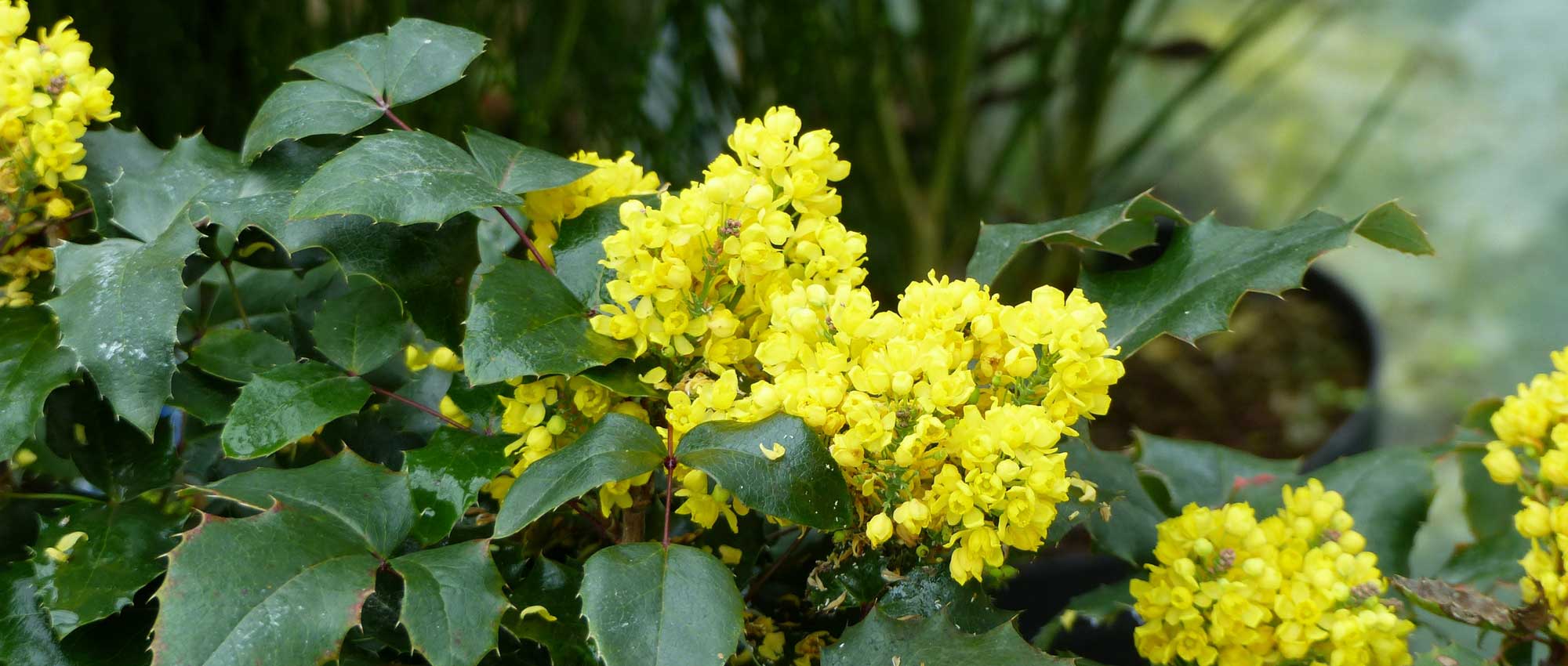
Mahonia : planting, pruning and care
Contents
Mahonia in a nutshell
- With its evergreen foliage and very bright flowering, it is a perfect bush for winter!
- It offers decorative berries, dark blue in spring.
- It is appreciated for its glossy, finely cut evergreen foliage, often very graphic!
- Its flowering is pleasantly fragrant.
- It easily finds its place in the shade, in a hedge, in a border, and can also be grown in isolation.
A word from our Expert
Mahonia is a shrub that offers a very bright flowering between autumn and early spring. It bears terminal clusters composed of a multitude of small yellow flowers, sometimes orange. It is also appreciated for its evergreen foliage, which remains decorative in winter. The leaves are divided into tough and shiny leaflets, which can be very fine. The most common species are Mahonia aquifolium, with holly-like leaves, and Mahonia x media, with more delicate foliage, including the very popular varieties ‘Charity’ and ‘Winter Sun’. There are many Asian species, such as the superb Japanese mahonia, Mahonia japonica.
Mahonia is a very easy plant to grow and is not demanding. It enjoys shaded situations and rather well-drained soils. It tolerates poor soils and, once established, withstands drought quite well. It is a perfect bush for hedges or borders, but can also adapt to container planting. It is best to carry out pruning after flowering, especially during the first few years. Once mature, it requires very little maintenance.
Botany
Botanical data
- Latin name Mahonia sp.
- Family Berberidaceae
- Common name Mahonia
- Flowering Between autumn and early spring
- Height often up to 2-3 metres, sometimes up to 5 metres
- Exposure shade or partial shade
- Soil type cool, rich and draining, airy
- Hardiness often down to -20 °C, for an adult specimen
The mahonia are shrubs that include nearly 70 species native to Asia and North America. The Mahonia aquifolium comes from North America, mainly from Oregon, California, and western Canada. It is sometimes referred to as the “Oregon Grape” (it is possible to make wine from the berries). Many species come from Asia: this includes Mahonia bealei, Mahonia japonica, and Mahonia eurybracteata. These Asian species are generally a bit less hardy than the others. Mahonias grow spontaneously in undergrowth or at the forest edge, and sometimes on rocky ground. This explains their preference for rather shaded exposures.
The mahonia was named in honour of the American botanist and horticulturist Bernard McMahon (1775 – 1816), founder of the Philadelphia Botanical Garden. It was imported to Europe in the early 19th century.
The mahonia belongs to the Berberidaceae family, the family of Berberis, epimedium, and heavenly bamboo (Nandina). It is particularly close to Berberis (or Barberry), with which it can hybridise to produce shrubs named (x) Mahoberberis, decorative for their evergreen, glossy, and spiny leaves, which take on beautiful colours in autumn.
The mahonia is a shrub with an upright habit and grows slowly. The Mahonia aquifolium only reaches 1 to 1.5 metres in height, while mahonia x media can measure up to 5 metres. Most varieties reach a maximum height of 3 metres. There are mahonias that are much shorter, such as Mahonia pumila and Mahonia repens, which do not exceed 30 centimetres in height. The mahonia has a beautiful, wrinkled, brown bark, marked with grey veins. Over time, the base of the shrub tends to become bare.
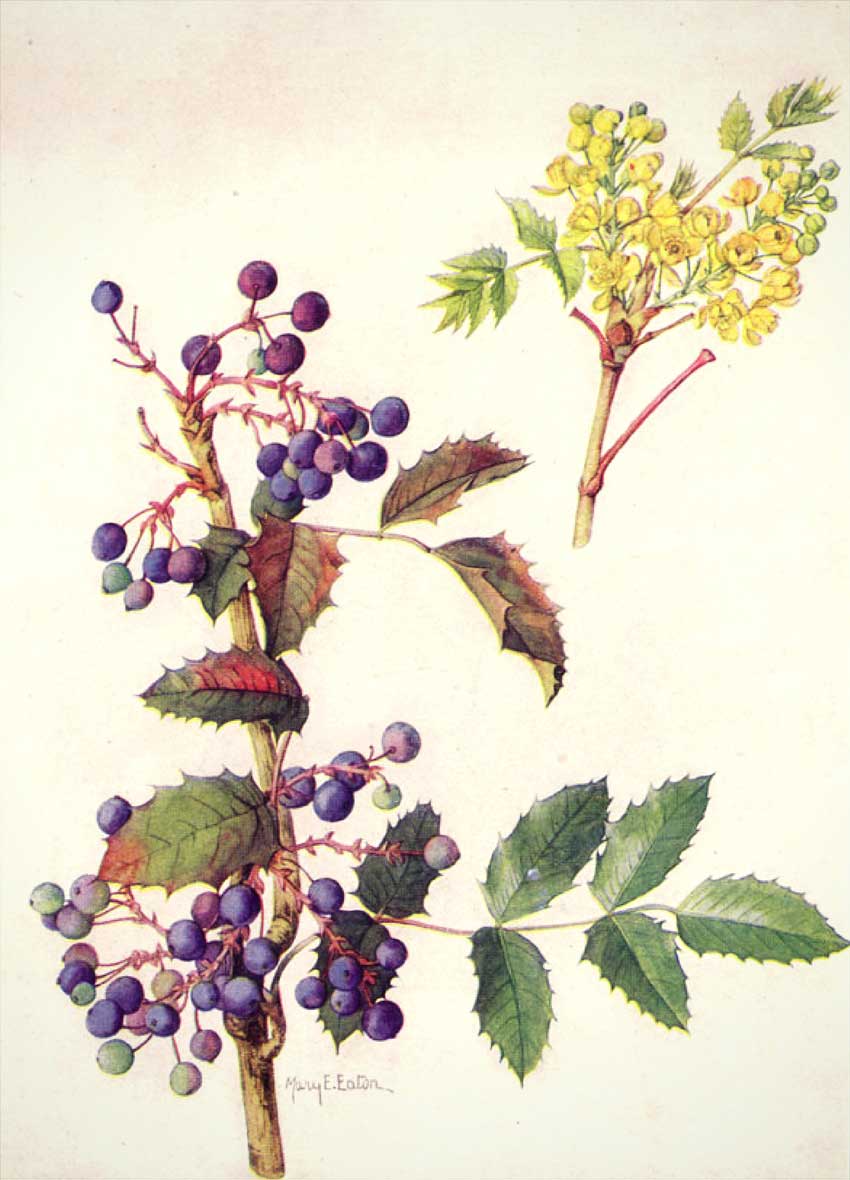
Mahonia aquifolium: botanical illustration
Depending on the varieties, mahonias flower between autumn and early spring. Thus, the mahonia ‘Soft Caress’ flowers very early in autumn, sometimes as early as August. As for the holly-leaved mahonia (Mahonia aquifolium), it flowers much later, in early spring, around March. The Mahonia x media ‘Charity’ is a variety that brightens gardens in mid-winter with its elegant yellow clusters. You can combine different varieties to enjoy their flowering over a longer period.
The flowers are grouped in terminal clusters, sometimes very elongated and fine. They can measure up to 50 centimetres in length. In some varieties, they are much more compact: thus, the Mahonia aquifolium has clusters that measure a maximum of 8 centimetres long. The flowers gradually bloom from the bottom to the top.
The flowers generally measure less than 2 centimetres in diameter. They are cup-shaped and a bright yellow colour, more rarely orange, as seen in the mahonia ‘Cabaret’. They are rounded and resemble those of Berberis. They consist of six to nine petaloid sepals, six petals, and six stamens. They are appreciated for bringing a lot of brightness in mid-winter.
The flowers of the mahonia are melliferous. They provide bees with nectar at a time when flowers are scarce. They release a pleasant lily of the valley fragrance. Feel free to use them to create bouquets or indoor decorations.
The leaves of the mahonia are thick (leathery), evergreen, and pinnate. They are very large and divided into spiny and glossy leaflets. They are dark green, sometimes bluish or silvery, but turn red, purple, or bronze in autumn. The young leaves are also in red hues. The Mahonia x wagneri ‘Moseri’ is truly impressive for the colours it takes on throughout the seasons: its leaves are yellow-green when young, then they become coppery green, and finally red in autumn!
Mahonias generally have long and large compound leaves. In Mahonia lomariifolia, they can reach up to 60 centimetres in length! In some varieties, they barely exceed 10 centimetres in length. Proportionally to their size, the leaves are composed of a more or less significant number of leaflets. Those of Mahonia aquifolium have only five to nine leaflets, while there are about twenty in Mahonia x media… But the record seems to be held by Mahonia lomariifolia, which has up to forty leaflets per leaf! They are then much finer, giving the whole leaf the appearance of a fern frond! The leaflets generally have spiny teeth… This is why those of Mahonia aquifolium resemble holly leaves so much.

The foliage of mahonias takes on various forms: from left to right, Mahonia ‘Soft Caress’, Mahonia aquifolium (photo Krzysztof Golik) and Mahonia fremontii (photo Genet)
If the foliage sometimes has a rather coarse and broad appearance, as in Mahonia aquifolium, mahonias can also impress us with their extremely fine leaves, as in the stunning Mahonia ‘Soft Caress’. They then appear much lighter and more delicate, airy, bringing an exotic touch to the garden. When they are very fine, they resemble fern fronds. In fact, the name Mahonia lomariifolia means “mahonia with Lomaria leaves,” Lomaria being a fern. They can also remind us of the leaves of heavenly bamboo, Nandina domestica. As its name suggests, the Mahonia ‘Soft Caress’ has very soft foliage, without thorns, unlike Mahonia aquifolium where the leaflets are leathery and spiny. Discover Mahonia ‘Soft Caress’ in our video:
The Mahonia aquifolium forms suckers, allowing it to spread. It can be multiplied by taking and transplanting these suckers.
After flowering, in summer or autumn, the mahonia offers decorative, rounded berries. They are dark blue, almost black. They are not edible raw but can be made into jam, wine, and liqueur. They are consumed by birds.
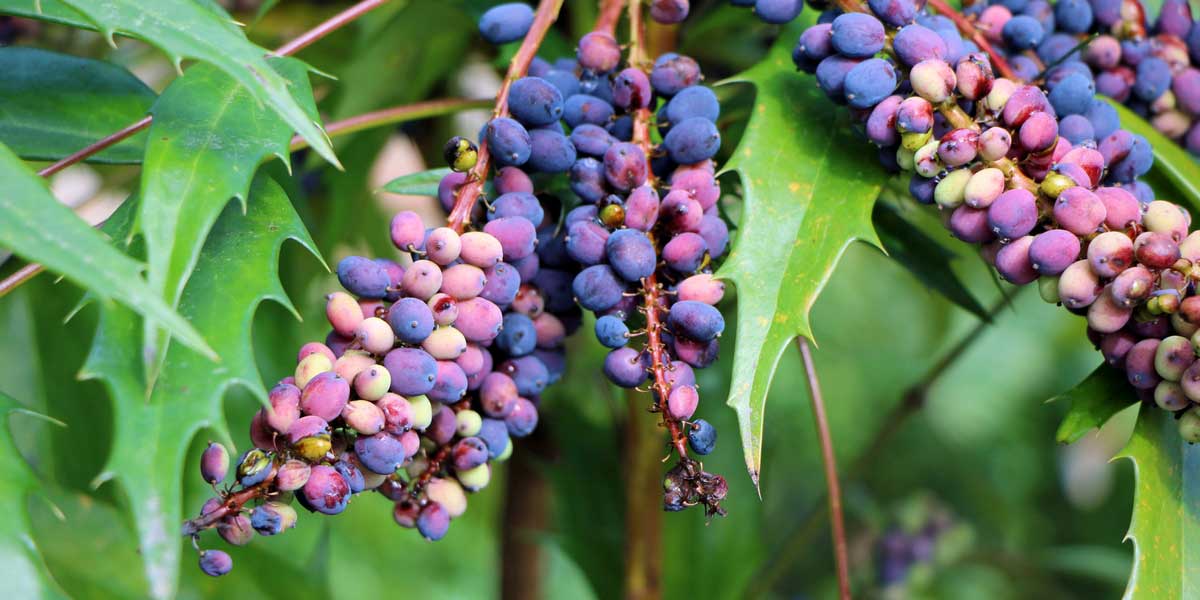
The berries of the Mahonia (photo Clanmother)
The main varieties of Mahonia
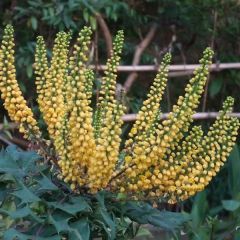
Mahonia x media Charity
- Height at maturity 3,50 m
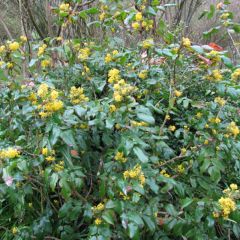
Mahonia aquifolium
- Flowering time March, April
- Height at maturity 1 m
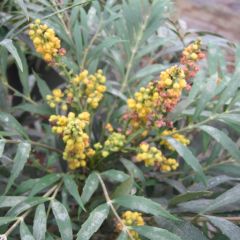
Mahonia confusa Nara Hiri - Hybrid Mahonia
- Height at maturity 1,20 m
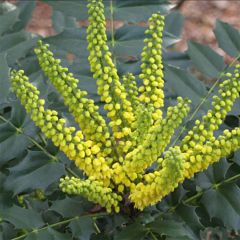
Mahonia japonica Hivernant
- Height at maturity 1,50 m
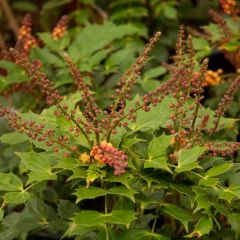
Mahonia nitens Cabaret
- Flowering time September to November
- Height at maturity 1,50 m
Discover other Mahonia
View all →Available in 2 sizes
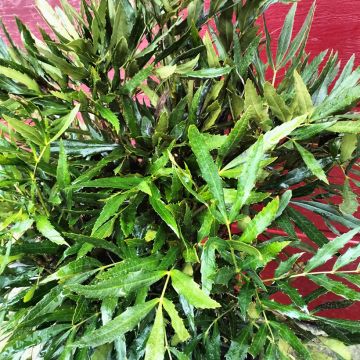
Available in 1 sizes
Available in 3 sizes
Available in 1 sizes
Available in 1 sizes
Available in 1 sizes
Available in 2 sizes
Available in 1 sizes
Available in 1 sizes
Available in 1 sizes
Planting
Where to plant?
Plant your mahonia preferably in shade or partial shade. It can, however, tolerate sunlight, especially if you live in the north of France. Conversely, in the south, it is best to avoid full sun and place it in partial shade instead. Mahonia thrives under deciduous trees.
Plant it preferably in neutral or slightly acidic soil, although some species, such as Mahonia aquifolium, tolerate limestone quite well.
It is important to install the mahonia in well-draining and porous soil, preferably sandy. Avoid heavy, compact, clayey soils, as they may suffocate the roots and retain water, which mahonias do not like. They do appreciate fertile soils that are rich in humus. We recommend adding some compost at planting.
Place it preferably in a sheltered location away from cold winds and frost, especially for varieties with very large leaves, such as Mahonia ‘Soft Caress’. These are the most sensitive to cold.
Due to its thorny foliage, we advise against placing it near a thoroughfare… unless you are growing mahonia ‘Soft Caress’, whose delicate foliage is thornless! This variety would be well-suited for pot planting, which you can place on a terrace.
Choose their location carefully, as once established, mahonias do not like to be moved.
When to plant?
Although it is possible to plant them throughout the year, ideally, it is best to do so from October until March or April. Avoid intervening during frost periods or when it is in full flowering.
How to plant?
Ideally, we suggest grouping three or five mahonias together, rather than planting them individually. You will achieve a more beautiful effect.
- Moisten the root ball to facilitate recovery.
- Dig a planting hole, two to three times the size of the root ball. Add some well-decomposed compost.
- Place the plant in the planting hole.
- Replace the soil and lightly firm it down.
- Water.
- Feel free to add a layer of mulch at its base. This will limit the growth of weeds and protect it from the cold while keeping the soil cool.
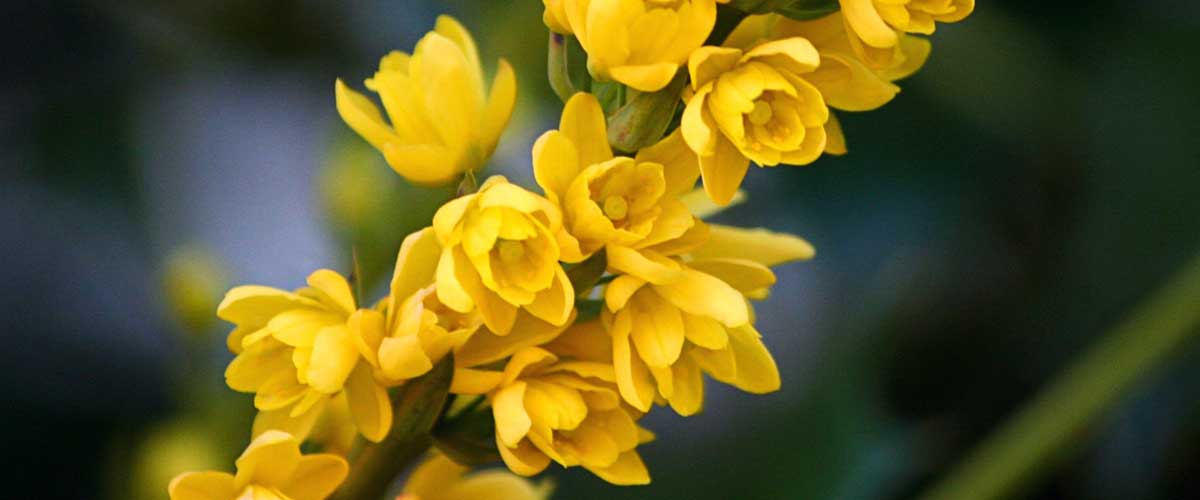
Care
Mahonia are bushes that require very little maintenance. Once they are mature, they do not need watering, but it is still preferable to water regularly during the first year and subsequently during dry periods. Similarly, if you are growing your mahonia in a pot or container, water occasionally, as the substrate dries out faster than in open ground.
Installing mulch at their base will help limit the growth of weeds and protect the bush from frost. You can also add some well-decomposed compost at the beginning of spring. Mahonias with the largest leaves (such as Mahonia ‘Soft Caress’) are the most sensitive to cold. If you are growing these varieties, protect them during the first few years with a winter cover and by placing a thick layer of mulch on the ground. Once mature, mahonia is quite resistant to cold. It is also advisable to stake mahonias during the first few years, as the weight of the clusters of leaves and flowers may cause the young branches, which are still flexible, to bend. Additionally, in case of snow, shake the bush to remove it and prevent the branches from breaking under the weight.
We advise you to prune mahonias after flowering, especially during the first few years – once mature, this operation becomes less necessary. Perform light pruning at the end of winter or the beginning of spring, around April. Remove damaged, broken, or poorly positioned branches, and cut the terminal leaf clusters. This will encourage the plant to branch out.
It is possible to enhance its silhouette by removing the leaves and branches that grow from the trunk, leaving only leaves and flowers at the top of the main stems. The mahonia will then take on a much more graphic and airy appearance, revealing its bark, which is rarely highlighted.
→ Learn more about pruning Mahonia: when and how in our advice sheet!
Thus, it is mainly the young plants of mahonias that require a bit of maintenance. Once mature, they generally do not need pruning or watering, no longer require staking, and become quite resistant to frost and drought.
Mahonia are susceptible to rust and powdery mildew. These are fungal diseases favoured by a combination of heat and humidity, and by a location that is too confined. Rust is characterised by the presence of small orange spots on the leaves, while powdery mildew is identified by the appearance of a white fluff on the foliage. Remove and burn the affected parts to prevent the spread of the disease. You can spray nettle manure, horsetail decoction, or sulphur. We advise you to limit watering and prune the mahonia to allow better air circulation. It can also happen that mahonia is affected by downy mildew. Very few insects or pests attack mahonia. It may occasionally be affected by aphids or by the holly leaf miner, a caterpillar that burrows galleries in the leaves.
→ Learn more about diseases and pests of Mahonia in our advice sheet!
Propagation
You can propagate Mahonia by sowing or by propagation by cuttings. Propagation by cuttings seems to be the best technique, as it is simple and will yield young plants more quickly, ensuring that they will be identical to the original variety. It is also possible to take suckers from Mahonia aquifolium just after flowering and transplant them.
Propagation by cuttings
Mahonia is propagated by cuttings from semi-ripe shoots, between August and October.
- Prepare a pot by filling it with a mixture of potting soil and sand, then moisten the substrate.
- Take a shoot about ten centimetres long from a current year’s growth. It should be healthy and free from diseases.
- Remove the leaves near the base of the cutting, and trim the others to reduce the leaf surface area. Leave only a few leaflets at the top.
- You may dip the base of the stem in plant hormone.
- Make a hole in the substrate using a pencil or a wooden stick.
- Place the cutting in the hole and gently firm the soil around it to eliminate air pockets and ensure good contact between the potting soil and the cutting.
- We recommend covering the pot with a plastic bag to maintain a humid atmosphere. Ventilate occasionally to prevent the development of fungal diseases.
- Place the pot in a warm, bright location but out of direct sunlight.
Sowing
Sow Mahonia seeds in spring. They need to undergo stratification (a period of cold) to break their dormancy, especially if they are from Mahonia aquifolium. Other varieties can be sown directly, without stratification. Germination of Mahonia seeds is irregular.
- Harvest the berries when they are fully ripe. Open them to retrieve the seeds.
- Stratify them to break their dormancy. To do this, place them in a tray filled with equal parts potting soil and sand, or just sand. Moisten the substrate and mix in the seeds. Seal everything in a plastic bag, then place it in a cold environment (between 0 and 5 °C), such as the refrigerator, for two to three months. Sometimes, seeds may germinate while still cold. In this case, take them out gradually and transplant them into pots.
- Remove the seeds from the refrigerator.
- Prepare a pot by filling it with a special seed compost.
- Place the seeds on the surface.
- Cover with a very thin layer of substrate, as they need light to germinate.
- Water.
Continue to water regularly, but without excess, to keep the substrate moist. Transplant the young seedlings a few months after germination. After a year, you can plant them in their final location.
Associating
Mahonia is a perfect bush for creating a splendid winter scene. Pair it with the elegant flowering of oriental hellebores or the discreet flowers of snowdrops. Enjoy the fragrant flowering of chimonanthus (Chimonanthus praecox) or that of daphne (Daphne odora). To warm up your garden in the middle of winter, combine it with other yellow flowers, such as those of Eranthis hyemalis, winter jasmine Jasminum nudiflorum, or witch hazel. You can add a few touches of orange or red to bring vitality.
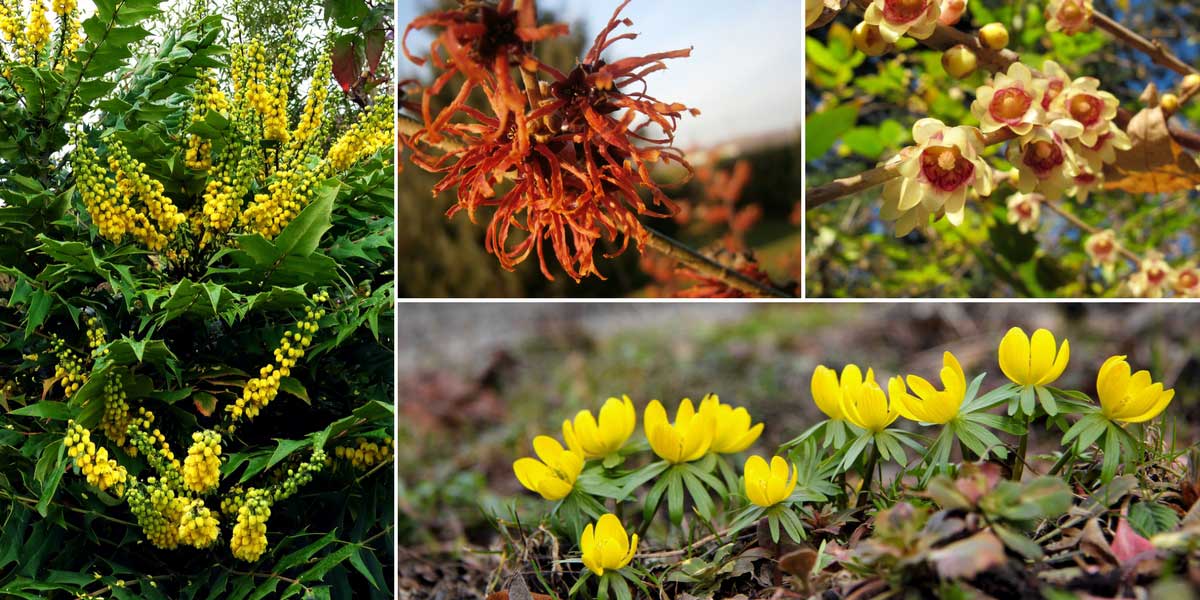
Pair mahonia with other winter flowers! Mahonia x media ‘Charity’, Hamamelis ‘Jelena’ (photo Meneerke bloem), Chimonanthus praecox (photo Kristine Paulus) and Eranthis hyemalis
Create a shrub bed by combining mahonia with other plants of winter interest, whether through their flowers (daphne, winter jasmine…), their wood (Cornus, Prunus…), their berries (Symphorine, Callicarpa…), or their evergreen foliage (Sarcococca, Viburnum tinus…). As mahonias flower at different times, you can combine several varieties to have continuous flowers from autumn to early spring!
Place it in the background of a flower bed. It will provide a beautiful backdrop, and you can place shorter plants in front of it: winter-flowering perennials or plants with decorative foliage (hostas, heucheras, ferns…). Feel free to combine Mahonia aquifolium, which flowers in early spring, with spring or late winter bulbs: daffodils, tulips, squills, wood hyacinths, crocuses, muscaris… As mahonia prefers rather shady situations, you can create a woodland garden by planting it alongside hostas, ferns, and hellebores.
With its original and finely divided foliage, and its delicate clusters of yellow flowers, mahonia has a very graphic quality. It will easily fit into a tropical-style garden, alongside other plants with large and broad divided foliage, creating a very lush appearance. Choose the ‘Soft Caress’ mahonia for its elegance, and pair it with ferns (especially the evergreen varieties), with Fatsia japonica or sacred bamboo (Nandina domestica). You can also combine ‘Cabaret’ mahonia, which flowers from August, with castor oil plant (Ricinus communis). Their warm shades of red, orange, and purple will create a warm and very exotic effect. Add some cannas and phormiums. Play with shapes and foliage, and combine mahonia with other graphic plants: bamboos, ferns, horsetails, sacred bamboo… If you live in the city, you can plant it in a pot on a terrace or in a courtyard, transforming it into a place filled with exoticism.
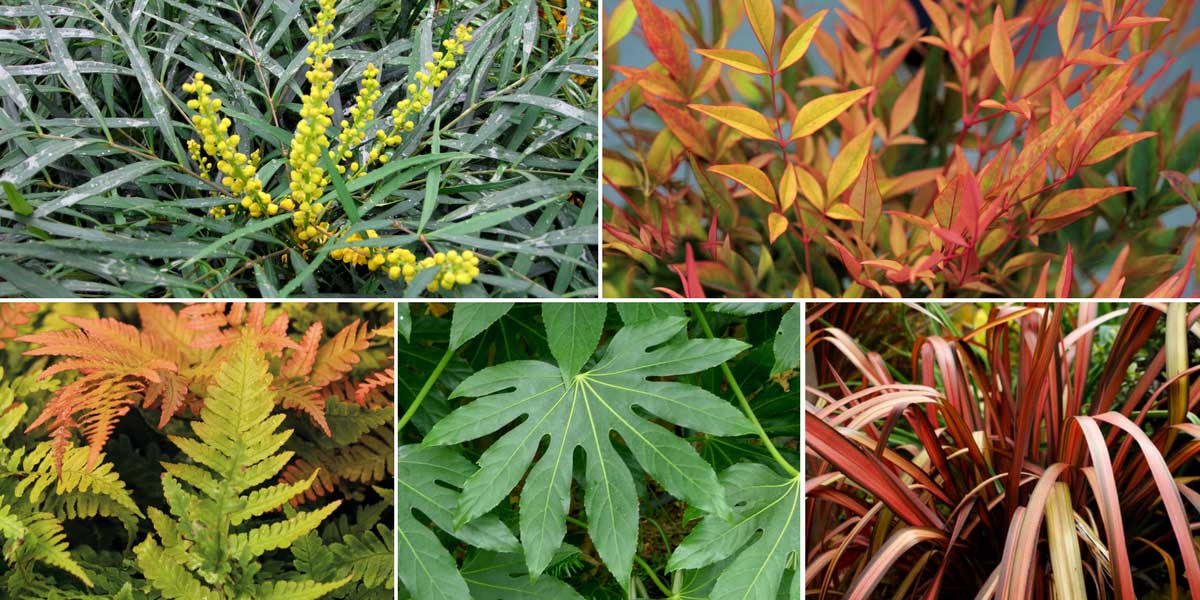
Enjoy mahonia to create an exotic scene! Mahonia ‘Soft Caress’, Nandina domestica ‘Gulf Stream’, Dryopteris erythrosora, Fatsia japonica (photo Dbxsoul) and Phormium ‘Pink Panther’
Mahonia is ideal for integrating into a country hedge, alongside laurustinus (Viburnum tinus), hornbeam, barberries, hawthorns, euonymus, privets… Add shrubs with decorative berries like callicarpa or symphorines. You will achieve a much livelier and colourful hedge than the classic laurel or thuja hedges. Moreover, it will require very little maintenance. You can create a defensive hedge by combining mahonia with other spiny shrubs (barberries, holly…).
Finally, some particularly elegant varieties deserve to be planted in isolation to highlight their foliage and impressive flowering. You can also group three or five plants of the same variety for a spectacular effect.
→ For more ideas to inspire you, check out our advice sheet: Mahonia: 7 ideas for pairing
Did you know?
- Uses
Although they are not edible raw, the berries of mahonia can be used to make jams, jellies, liqueurs, or wine. The roots of Mahonia aquifolium can also be used to obtain a yellow dye. The leaves, bark, and roots have medicinal properties and may have been used in the past to treat dermatological or hepatic issues (liver conditions). They also possess diuretic, anti-inflammatory, and digestive properties.
- The Emblem of Oregon
As Mahonia aquifolium is native to Oregon, it has become the symbol of this state located on the west coast of the United States. It is also known as Oregon grape: Oregon vine, as it is possible to make wine from its berries.
Useful resources
-
- Discover our range of mahonias!
- An article by Pascal on our blog – Flowering hedge: which bushes to plant, when and how?
- Another article by Pascal – Flowering your garden in winte
- Advice sheet: Mahonia: 7 association ideas
- Advice sheet: Choosing a Mahonia
- Advice sheet: 7 Mahonias with autumn flowering, 6 Mahonias with winter flowering, 5 mahonias with fragrant flowers
Frequently asked questions
-
The leaves of my mahonia have small coppery spots. What should I do?
Your mahonia is affected by rust, a disease caused by a fungus. It is characterised by the appearance of small rust-coloured spots on the leaves, and brown pustules on the underside. The leaves may eventually fall off. This disease, although it weakens the plant and is unsightly, is not really dangerous. The mahonia will survive. As soon as you notice the first symptoms, remove and burn the affected leaves. You can then spray with nettle manure or a horsetail decoction.
-
The foliage of my Mahonia is covered in a white fluff.
Your mahonia is affected by powdery mildew. Like rust, this disease is caused by a fungus. It is encouraged by heat and humidity, as well as a confined atmosphere. The leaves become covered with a greyish-white felt. Remove and burn the affected parts. You can treat it by spraying horsetail manure or sulphur. Afterwards, we advise you to limit watering, and especially to avoid wetting the foliage, as well as to prune the bush to allow air to circulate well in the centre of the plant.
- Subscribe!
- Contents































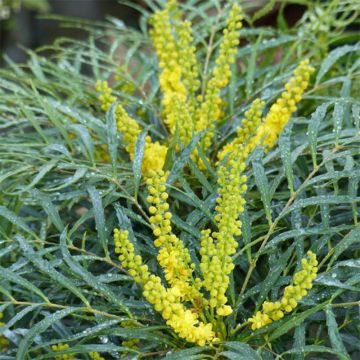

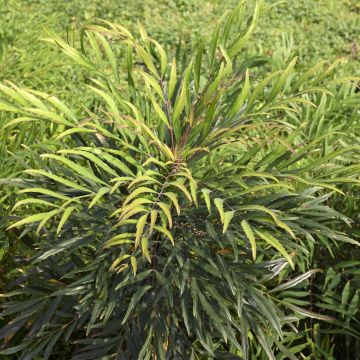

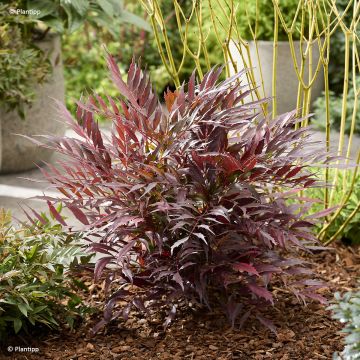


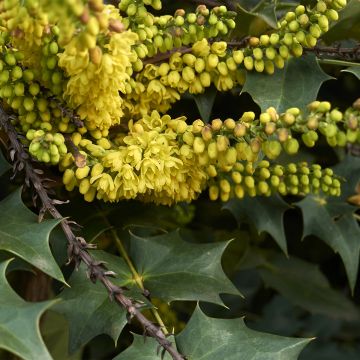
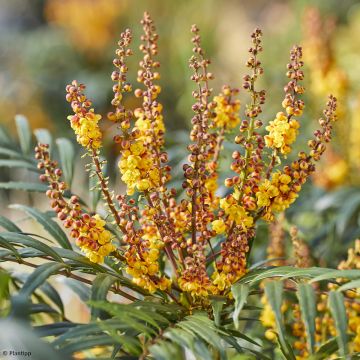
Comments